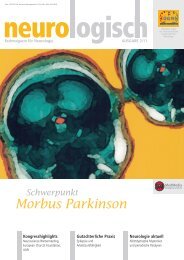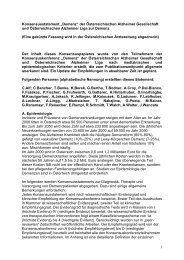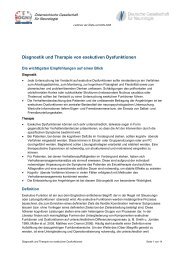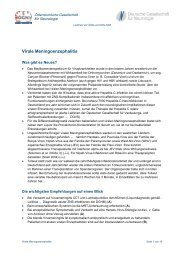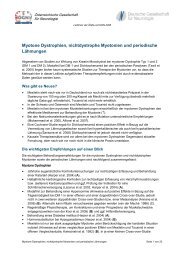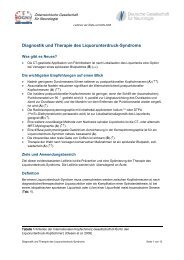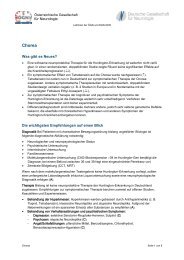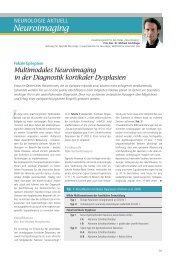Neues aus der Epileptologie - Ãsterreichische Gesellschaft für ...
Neues aus der Epileptologie - Ãsterreichische Gesellschaft für ...
Neues aus der Epileptologie - Ãsterreichische Gesellschaft für ...
Sie wollen auch ein ePaper? Erhöhen Sie die Reichweite Ihrer Titel.
YUMPU macht aus Druck-PDFs automatisch weboptimierte ePaper, die Google liebt.
Aufwandes unter längerer EEG-Monitoring-<br />
Dauer sicherlich eine eher kostenintensivere<br />
Untersuchung.<br />
Resümee<br />
In <strong>der</strong> vorliegenden Arbeit wird ein Überblick<br />
über klinische Anwendung von nuklearmedizinischen<br />
Methoden in <strong>der</strong> Diagnostik <strong>der</strong><br />
Epilepsie gegeben. Hierbei liegt <strong>der</strong> Schwerpunkt<br />
in <strong>der</strong> prächirurgischen Epilepsiediagnostik<br />
bei therapieresistenten fokalen Epilepsien.<br />
Iktale Bildgebung kann mit iktalem SPECT<br />
und SISCOM dargestellt werden. Bei erfolgreicher<br />
iktaler Injektion zeigt sich vor allem<br />
bei komplex-fokalen Anfällen eine hohe lokalisatorische<br />
Aussagekraft <strong>der</strong> Hyperperfusion.<br />
Diese kann zur Generierung von Implantationshypothesen<br />
o<strong>der</strong> auch zur Bestätigung<br />
<strong>der</strong> OP-Lokalisation beitragen.<br />
FDG-PET stellt bei Temporallappenepilepsien<br />
einen ipsilateralen temporalen Hypometabolismus<br />
dar, <strong>der</strong> mit gutem postoperativem<br />
Anfalls-Outcome korreliert. Temporale hypometabole<br />
Zonen können zwischen mesialer<br />
Temporallappenepilepsie und nichtläsioneller<br />
Temporallappenepilepsie variieren.<br />
Neben FDG-PET, das beson<strong>der</strong>s gut zur Lateralisation<br />
von Temporallappenepilepsien<br />
geeignet ist, wird Flumazenil-PET zur interiktalen<br />
Darstellung des epileptogenen Fokus<br />
eingesetzt. Hier besteht eine hohe Korrelation<br />
zur interiktalen Spike-Aktivität und bei<br />
Resektion zum postoperativen Outcome.<br />
Aufgrund <strong>der</strong> Eigenschaften des Flumazenil-<br />
Tracers ist dieser lei<strong>der</strong> nur an bestimmten<br />
Orten verfügbar. Rezente Publikationen warfen<br />
die Frage auf, ob Flumazenil ein P-Glykoprotein-Korrelat<br />
sein könnte.<br />
Die Wichtigkeit von ökonomischen Faktoren<br />
im Rahmen <strong>der</strong> einzelnen diagnostischen<br />
Schritte in <strong>der</strong> prächirurgischen Epilepsiediagnostik<br />
wird kurz beleuchtet.<br />
Zusammenfassend lässt sich festhalten, dass<br />
im Rahmen <strong>der</strong> Diagnostik von Epilepsien<br />
nuklearmedizinische Untersuchungsmethoden<br />
nur in <strong>der</strong> prächirurgischen Epilepsiediagnostik<br />
eingesetzt werden sollten. Eine weitere,<br />
seltenere Indikation stellt die Abklärung<br />
an<strong>der</strong>er Erkrankungen dar, die eine Epilepsie<br />
hervorrufen können, wie z. B. Screening für<br />
paraneoplastische Syndrome. <br />
•<br />
Danksagung: Dank gilt Priv.-Doz. Prim. Dr. R. Pichler,<br />
Institut für Nuklearmedizin, Landesnervenklinik<br />
Wagner-Jauregg, für die Bereitstellung <strong>der</strong> Bil<strong>der</strong><br />
für die Abbildungen 2 und 3.<br />
1 Dong C et al., Aphasic or amnesic status epilepticus<br />
detected on PET but not EEG. Epilepsia 2009;<br />
50(2):251–5<br />
2 Bauer G, Unterberger I, Trinka E, Comment on<br />
„Aphasic or amnesic status epilepticus detected<br />
on PET but not EEG“. Epilepsia 2009;<br />
50(8):2004–5<br />
3 Weitemeyer L et al., The prognostic value of [F]FDG-<br />
PET in nonrefractory partial epilepsy. Epilepsia 2005;<br />
46(10):1654–60<br />
4 O’Brien TJ et al., Subtraction ictal SPECT co-registered<br />
to MRI improves clinical usefulness of SPECT in localizing<br />
the surgical seizure focus. Neurology 1998 Feb;<br />
50(2):445–54<br />
5 Spanaki MV et al., Sensitivity and specificity of quantitative<br />
difference SPECT analysis in seizure localization.<br />
J Nucl Med 1999; 40(5):730–6<br />
6 Spanaki MV et al., Periictal SPECT localization verified<br />
by simultaneous intracranial EEG. Epilepsia 1999;<br />
40(3):267–74<br />
7 O’Brien TJ et al., Subtraction peri-ictal SPECT is<br />
predictive of extratemporal epilepsy surgery outcome.<br />
Neurology 2000 Dec 12; 55(11):1668–77<br />
8 O’Brien TJ et al., Comparative study of 99mTc-ECD<br />
and 99mTc-HMPAO for peri-ictal SPECT: qualitative<br />
and quantitative analysis. J Neurol Neurosurg Psychiatr<br />
1999; 66(3):331–9<br />
9 Lee Sk et al., Ictal SPECT in neocortical epilepsies: clinical<br />
usefulness and factors affecting the pattern of<br />
hyperperfusion. Neuroradiology 2006; 48(9):678–84<br />
10 Von Oertzen TJ et al., Prospective use of subtraction<br />
ictal SPECT coregistered to MRI (SISCOM) in presurgical<br />
evaluation of epilepsy. Epilepsia 2011;<br />
52(12):2239–48<br />
11 Shin WC et al., Ictal hyperperfusion patterns according<br />
to the progression of temporal lobe seizures.<br />
Neurology 2002; 12;58(3):373–80<br />
12 Van Paesschen W et al., Self-injection ictal SPECT<br />
during partial seizures. Neurology 2000 May 23;<br />
54(10):1994–7<br />
13 Lee JJ et al., Ictal SPECT using an attachable automated<br />
injector: clinical usefulness in the prediction of<br />
ictal onset zone. Acta Radiol 2009;<br />
50(10):1160–8<br />
14 Setoain X et al., Validation of an Automatic Dose<br />
Injection System for Ictal SPECT in Epilepsy. J Nucl<br />
Med 2012; 53(2):324–9<br />
15 O’Brien TJ et al., Subtraction SPECT coregistered to<br />
MRI in focal malformations of cortical development:<br />
localization of the epileptogenic zone in epilepsy surgery<br />
candidates. Epilepsia 2004; 45(4):367–76<br />
16 Kotagal P et al., Psychomotor seizures of temporal<br />
lobe onset: analysis of symptom clusters and sequences.<br />
Epilepsy Res 1995; 20(1):49–67<br />
17 Dupont P et al., Ictal perfusion patterns associated<br />
with single MRI-visible focal dysplastic lesions: implications<br />
for the noninvasive delineation of the epileptogenic<br />
zone. Epilepsia 2006; 47(9):1550–7<br />
18 Knowlton RC et al., Functional imaging: II. Prediction<br />
of epilepsy surgery outcome. Ann Neurol 2008;<br />
64(1):35–41<br />
19 Ahnlide JA et al., Does SISCOM contribute to favorable<br />
seizure outcome after epilepsy surgery? Epilepsia<br />
2007; 48(3):579–88<br />
20 Tan KM et al., Influence of subtraction ictal SPECT on<br />
surgical management in focal epilepsy of indeterminate<br />
localization: a prospective study. Epilepsy Res 2008;<br />
82(2-3):190–3<br />
21 Kim DW et al., Predictors of surgical outcome and<br />
pathologic consi<strong>der</strong>ations in focal cortical dysplasia.<br />
Neurology 2009; 20;72(3):211–6<br />
22 Alarcón G et al., Is it worth pursuing surgery for epilepsy<br />
in patients with normal neuroimaging? J Neurol<br />
Neurosurg Psychiatr 2006; 77(4):474–80<br />
23 Theodore WH et al., The role of positron emission<br />
tomography in the evaluation of seizure disor<strong>der</strong>s.<br />
Ann Neurol 1984; 15(Suppl):S176–9<br />
24 Henry TR et al., Hippocampal neuronal loss and regional<br />
hypometabolism in temporal lobe epilepsy. Ann<br />
Neurol 1994; 36(6):925–7<br />
25 Vinton AB et al., The extent of resection of FDG-PET<br />
hypometabolism relates to outcome of temporal<br />
lobectomy. Brain 2007; 130(Pt 2):548–60<br />
26 Vielhaber S et al., Correlation of hippocampal glucose<br />
oxidation capacity and interictal FDG-PET in temporal<br />
lobe epilepsy. Epilepsia 2003; 44(2):193–9<br />
27 Carne RP et al., „MRI-negative PET-positive“ temporal<br />
lobe epilepsy (TLE) and mesial TLE differ with quantitative<br />
MRI and PET: a case control study. BMC Neurol<br />
2007; 7:16<br />
28 Koepp MJ et al., 11C-flumazenil PET, volumetric MRI,<br />
and quantitative pathology in mesial temporal lobe<br />
epilepsy. Neurology 1997; 49(3):764–73<br />
29 Debets RM et al., Is 11C-flumazenil PET superior to<br />
18FDG PET and 123I-iomazenil SPECT in presurgical<br />
evaluation of temporal lobe epilepsy? J Neurol Neurosurg<br />
Psychiatr 1997; 62(2):141–50<br />
30 Richardson MP et al., 11C-flumazenil PET in neocortical<br />
epilepsy. Neurology 1998; 51(2):485–92<br />
31 Muzik O et al., Intracranial EEG versus flumazenil and<br />
glucose PET in children with extratemporal lobe epilepsy.<br />
Neurology 2000 Jan 11; 54(1):171–9<br />
32 Juhász C et al., Relationship between EEG and positron<br />
emission tomography abnormalities in clinical epilepsy.<br />
J Clin Neurophysiol 2000; 17(1):29–42<br />
33 Odano I et al., [18F]flumazenil binding to central benzodiazepine<br />
receptor studies by PET--quantitative analysis<br />
and comparisons with [11C]flumazenil. Neuroimage<br />
2009 Apr 15; 45(3):891–902<br />
34 Froklage FE et al., [11C]Flumazenil brain uptake is<br />
influenced by the blood-brain barrier efflux transporter<br />
P-glycoprotein. EJNMMI Res 2012 Mar 28; 2:12<br />
35 Syvänen S et al., Altered GABAA Receptor Density<br />
and Unaltered Blood-Brain Barrier Transport in a Kainate<br />
Model of Epilepsy: An In Vivo Study Using<br />
11C-Flumazenil and PET. J Nucl Med 2012 Dec;<br />
53(12):1974–83<br />
36 Laufs H et al., Converging PET and fMRI evidence for<br />
a common area involved in human focal epilepsies.<br />
Neurology 2011 Aug 30; 77(9):904–10<br />
37 Ohta Y et al., Voxel- and ROI-based statistical analyses<br />
of PET parameters for guidance in the surgical treatment<br />
of intractable mesial temporal lobe epilepsy.<br />
Ann Nucl Med 2008 Jul; 22(6):495–503<br />
38 Fedi M et al., alpha-[11C]-Methyl-L-tryptophan PET<br />
identifies the epileptogenic tuber and correlates with<br />
interictal spike frequency. Epilepsy Res 2003;<br />
52(3):203–13<br />
39 Kagawa K et al., Epilepsy surgery outcome in children<br />
with tuberous sclerosis complex evaluated with alpha-<br />
[11C]methyl-L-tryptophan positron emission tomography<br />
(PET). J Child Neurol 2005; 20(5):429–38<br />
40 Engel JJ et al., Outcome with respect to epileptic seizures.<br />
Surgical treatment of the epilepsies. 2nd ed.,<br />
Raven Press Ltd, New York 1993; p609–21<br />
41 O’Brien TJ et al., The cost-effective use of 18F-FDG<br />
PET in the presurgical evaluation of medically refractory<br />
focal epilepsy. J Nucl Med 2008; 49(6):931–7<br />
33



